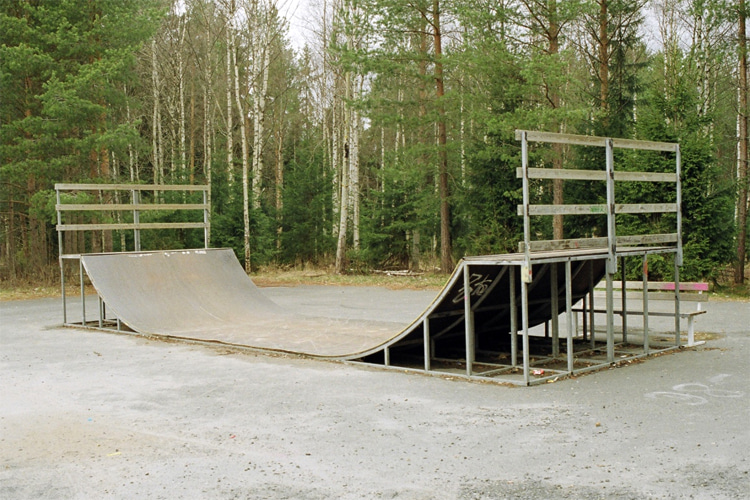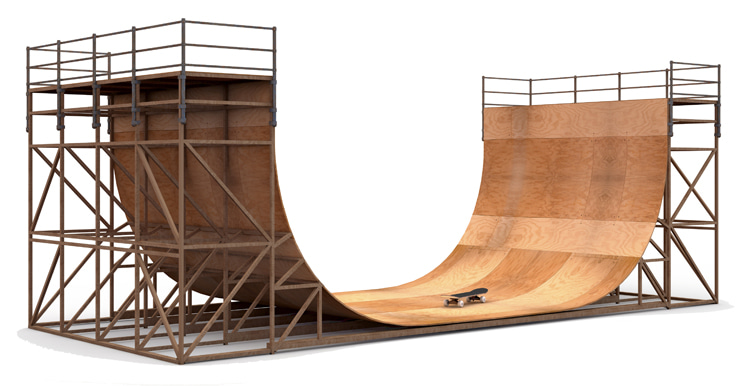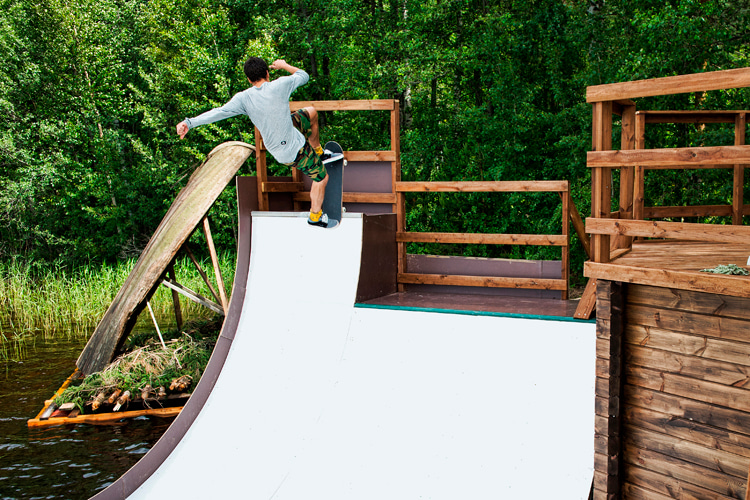Learn how to build a custom-made half-pipe - or mini ramp - for your backyard, patio, or community.
Generally speaking, a half-pipe and a mini ramp mean the same thing.
Nevertheless, if you're meticulous and rigorous about both concepts, you'd say a mini ramp is a half-pipe without the vert section.
But the architecture of it all is identical, so the following DIY project can be changed to fit your needs.
One of the first things you need to know is where you're going to put it.
After figuring out where it will be installed, it's time to make a sketch and set its dimensions - length, width, and height.
You can start by getting a few inspiring ideas by browsing online and creating a shortlist of quality and easy-to-build half-pipes.
In the end, you'll want a smooth riding surface and a relatively light and highly portable structure with easily accessible uninstallation options.
The following project can become a reality for around $1,200. For a less expensive mini ramp, reduce the scale by 25 or 33 percent.

Preparation
The half-pipe must be installed on solid horizontal surfaces to avoid unintentional shifts and potential injuries.
So, make sure you're building a mini ramp in a place where the structure will sit comfortably. Ideally, it's always better to build it on a flat-leveled concrete pad.
The first thing you should be creating is the transitions, the curved areas of the ramp located on both sides of the ramp.
If you opt for a modular design, you'll be able to swap sizes in the future or remove one of the transitions and stick with the quarter pipe.
The flexibility of a modular model will allow you, for instance, to ride a half-pipe one day and then enjoy a smaller quarter pipe a month later to save space.
So, if you're building a mini ramp and have a place for it, go for the half-pipe version.
Materials
The following materials allow you to build a 24-foot (7.3 meters) long, 12-foot (3.65 meters) wide, and three-foot (0.9 meters) high half-pipe.
If you prefer a smaller or bigger structure, adjust the proportion/ratios.
You'll need:
- 2x4'' Lumber Studs
- 3/4'' Plywood Sheets
- 3/8'' Plywood Sheets
- 1/8'' Plywood Sheets
- 2'' OD Steel Pipe
- Exterior Latex Paint
- 2.5'' Exterior Screws
- 1.5'' Exterior Screws
- 1/2'' Galvanized Bolts/Nuts/Washers
Tools
You'll also need a few essential tools. Some of them you might already have; others you might need to buy or borrow from a friend or neighbor.
You'll need:
- Miter Saw
- Circular Saw
- Drill
- Impact Driver
- Cobalt Drill Bits
- Countersink Drill Bit
- Level
- Tape Measure
- Chalk Line
- Pencil

Building Instructions
Building a half-pipe might take a while.
Expect between four to eight days of work, depending on the number of hours and helping hands assigned to the project.
Make sure to take a look at the weather forecast. You don't want the rain to ruin your skate ramp.
In order to have a wide half-pipe where you can let your four wheels roll freely, this project will include four quarter pipes.
In other words, there will be eight plywood transition pieces.
1. Cutting the Curvature
Line up a couple of sheets and determine a pivot point. Then, put a screw in and attach a piece of string cut to the same length of the radius of our curve. For example, six feet.
Attach a pencil to it, and then draw a line that matches the curve you want to use.
Measure and mark out the rest of the transition pieces. You'll be getting two of them from a single sheet of 3/4-inch plywood.
Cut everything out with a jigsaw.
Use the first piece as a template to copy the same exact curve onto the rest of the boards.
2. The Lumber Studs
The next step is to trim up the 2x4'' lumber studs to frame out the quarter pipes so the ramp is exactly 12 feet wide, and it's broken up into two quarter pipes - one of which is exactly 8 feet and the other one's precisely 4 feet.
Mark and cut several 2x4'' studs and begin framing using the 2.5'' exterior screws.
Once the quarter pipes are framed and placed where you want them to be, bolt them together, making sure they're leveled and squared up.
Build the flat middle section and confirm that everything fits and is lined up.
3. The Coping
A half-pipe without a coping is not a half-pipe.
On the top corner of the quarter pipes, there's a notch designed to accommodate the coping.
Now, it's time to drill several holes to attach the coping to the quarter pipe.
4. Installing the Plywood Deck
Installing the plywood deck is probably the only part of the project where you need two people.
You'll need at least one person putting weight onto the plywood to bend it to the transition and a second person screwing it all in.
Bending the plywood is easy because 3/8 inch plywood is really flexible, and then you have to push it into place and screw it.
If you use two plywood layers, make sure each sheet is offset from the one below it to ensure that all the screws don't end up in the same place.
Time for the final layer of wood - the 1/8'' plywood.
The surface layer should be installed diagonally so that when you're riding over the ramp, you're not hitting a line.
When the seams are diagonal, the two wheels never hit a seam at once, and it will always be a more comfortable ride.
Since this is an outdoor ramp, make sure there's a gap between each of the sheets to account for any expansion that might occur when it's humid or rainy.
5. The Paint Job
Now that the final layer of plywood is on, it's time to paint it.
However, before the exterior paint, consider applying a bead of caulking in all of the expansion joints.
The trick is to allow for a little bit of wood movement and prevent rainwater from getting in and underneath and destroying the wood structure.
